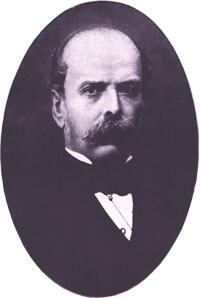- Filippo Pacini
Infobox Scientist
box_width =
name = Filippo Pacini
image_size =
caption =
birth_date = 1812-05-25
birth_place =Pistoia ,Tuscany
death_date = 1883-07-09
death_place =Florence
residence =Florence
citizenship = Italian
nationality = Italian
ethnicity = Italian
fields = Anatomy
workplaces = Institute of Human AnatomyFlorence LyceumUniversity of Florence Istituto di Studi Superiori
alma_mater =Pistoia
doctoral_advisor =Paolo Savi
academic_advisors =
doctoral_students =
notable_students =
known_for =Pacinian corpuscles Vibrio cholerae
author_abbrev_bot =
author_abbrev_zoo =
influences =
influenced =
awards =
religion =Roman Catholic
footnotes =Filippo Pacini (
May 25 ,1812 –July 9 ,1883 ) was an Italiananatomist , posthumously famous for isolating thecholera bacillus "Vibrio cholerae " in 1854, well beforeRobert Koch 's more widely accepted discoveries thirty years later.Pacini was born in
Pistoia ,Tuscany to a humble family, but was given a religious education in hopes that he would become a bishop. However, in 1830 he was given a scholarship to the venerable medical school in Pistoia. He learned his trade as a physician, and learned to dissect and examine bodies with a microscope.In 1831, during a dissection class, Pacini discovered small sensory organs in the
nervous system which can detect pressure and vibrations. He studied them closely from 1833 on, and first discussed them in 1835 at the "Società medico-fisica" in Florence, but did not publish his research ("Nuovi organi scoperti nel corpo umano") until 1840. Within just a few years, the work was widely known in Europe and the bodies had become known asPacinian corpuscles .He served as an assistant to
Paolo Savi inPisa from 1840 to 1843, then began working at the Institute of Human Anatomy. In 1847 Pacini began teaching at the Lyceum in Florence, and then was named chair of General and Topographic Anatomy at the "Istituto di Studi Superiori" at theUniversity of Florence in 1849, where he remained to the end of his career.The
Asiatic Cholera Pandemic of 1846-63 which swept through Florence in 1845–1846 brought the disease to the center of Pacini's attention. In 1854 he described the disease in a paper called "Microscopical observations and pathological deductions on cholera", but because of the prevailing belief of Italian scientists in themiasma theory of disease , the work was not noted by others until many years after his death, despite additional publications in 1865, 1866, 1871, 1876, and 1880 which identified the cause of the disease's lethality, and even proposed some effective treatments. John Snow, who disproved the miasma theory, andRobert Koch , widely credited with the discovery of the bacillum thirty years later, were unaware of his previous work.When Koch, a much more widely respected scientist who had previously identified the
tuberculosis bacillus, presented his findings to the Cholera Commission of the Imperial Health Office in Berlin in 1884, the commission congratulated him, but also recognized Pacini's previous discovery of the bacterium. In 1965, the international committee on nomenclature adopted the formal name "Vibrio cholerae Pacini 1854" to honor his work.During his career Pacini also published several studies on the retina of the human eye, the electric organs in electric fishes, the structure of bone, and the mechanics of respiration.
Pacini did not marry, and spent most of the money remaining after his scientific investigation on the long term care of his two ailing sisters. He died nearly penniless in Florence on
July 9 ,1883 , and was buried in the cemetery of the Misericordia. In 1935 his remains were transferred to the church of Santa Maria delle Grazie, along with the remainsAtto Tigri andFilippo Civinini , two other noted anatomists.References
* [http://www.ph.ucla.edu/epi/snow/firstdiscoveredcholera.html UCLA: Who first discovered cholera?]
* [http://www.whonamedit.com/doctor.cfm/2605.html Who Named It: Filippo Pacini]
Wikimedia Foundation. 2010.
